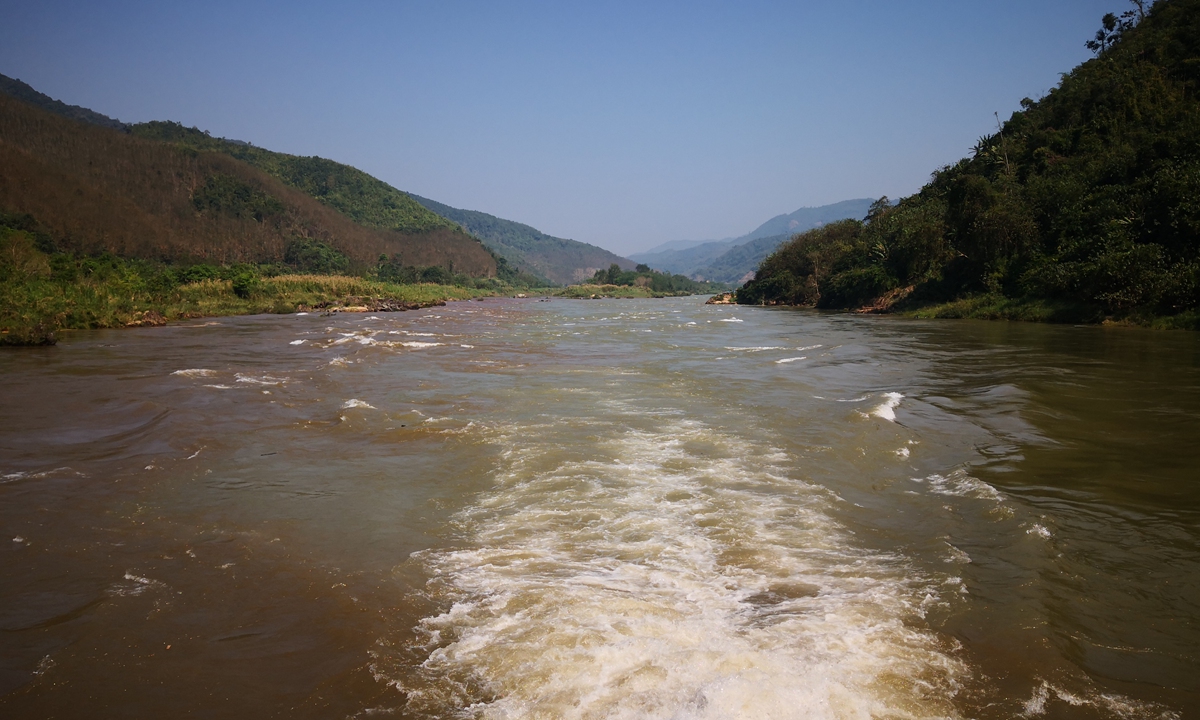River dams in China helped alleviate drought along Lancang-Mekong, research finds
By Hu Yuwei Source: Global Times Published: 2020/7/15 20:48:40

A fisherwoman walks on an embankment on October 31, 2019, on the Mekong River in Pak Chom district in Thailand during the drought. Photo: AFP
China was one of the countries that suffered the most from a severe drought along the Lancang-Mekong River in 2019, hydrology researchers found, in contrast with allegations by some foreign researchers which blamed China for the drought in countries on lower reaches of the river.
As a severe drought hit countries in the Lancang-Mekong River Basin (LMRB) from late 2019 to early 2020, risking water shortages and damage to crop production, some US media outlets blamed China for the disaster. Such reports alleged dams built in China controlled the upstream flow to use the water for domestic hydropower or irrigation.
A latest report by Chinese researchers refuted this causal link and reckless accusation by US media, as scientists have found continued high temperatures and decreasing rainfall are the main causes of the drought.
Scholars from Tsinghua University's Centre for International Transboundary Water and Eco-Security and researchers from the Department of Hydraulics at China Institute of Water Resources and Hydropower Research collected hydro meteorological data covering both upstream and downstream areas and utilized state-of-the-art methods to investigate the drought's effects on the LMRB and the impact of reservoir regulation on stream flow.
More than 10 global experts from the US, UK, LMRB countries, and cross-national organizations at an virtual international seminar acknowledged on Tuesday the sound research methods and evidence used in the Chinese scholars' research on the main causes of the severe regional drought in 2019. They agreed that cascade reservoirs along the Lancang River helped alleviate the drought downstream.
The report's conclusion echoed the Mekong River Commission - an inter-governmental river basin organization - which concluded in November 2019 that the drought was caused by insufficient rainfall during the wet season with a delayed arrival and earlier departure of the monsoon rain, and an El Niño event that led to abnormally high temperatures and high evapotranspiration.
However, this conclusion has been constantly denied and ignored by foreign media and some US institutions. Some observers said such denial comes from attempts to play countries along the LMRB against each other.
Scientific facts provided by the report by Chinese scholars attempt to help enhance understanding and mutual trust in the upstream and downstream of the LMRB, and promote jointly responding to drought and other issues in the basin, Tian Fuqiang, the Chinese report's leading writer from Tsinghua University, told the Global Times on Tuesday.

Mekong River in February 2019 Photo: Li Qian/GT
Cause of drought
Originating from the Qinghai-Tibet Plateau in China, the Lancang River is called Mekong in countries on its lower reaches like Laos, Myanmar, Thailand and Vietnam. The river is a life-source for over 60 million people in the region.
The LMRB experienced one of the most severe droughts over the past century in late 2019. China, which has suffered more frequent droughts than downstream countries over the past 60 years, was not immune to the latest round of damages.
The occurring frequency of severe droughts in the LMRB is about 7 percent, reaching up to 12 percent in the upper and middle areas of the Lancang sub-region during the past 60 years, said the report, indicating that China faces a higher risk of drought.
For the downstream part of the LMRB, about half of the area experienced an increase of severe and rare droughts. Affected regions were principally in Thailand, eastern Cambodia and part of Vietnam, while most areas of Laos, the western part of Cambodia, and part of the Mekong Delta area experienced a decrease of severe and droughts.
Researchers also explored the impact of reservoir regulation on the mainstream discharge of the Mekong River, finding well-operated reservoirs, such as dams which store water in wet seasons and release water in dry seasons, helped with drought relief in the LMRB as a whole. Data shows the odds of drought occurring in the dry season are significantly higher than that in the wet season.
On April 21, the Mekong River Commission Secretariat made a science-based assessment on this drought, based on its weekly flood situation reports for a period of time. The assessment found that reduced precipitation and abnormality in the monsoon season combined with an extreme El Niño event was the main cause of the drought. There is no reason in justifying the claim China is responsible for the drought in downstream countries, it concludes.
Southwest China's Yunnan Province has also been suffering from a severe drought since last year. Despite this, China has been doing its best to guarantee reasonable discharge volumes downstream, Chinese Foreign Ministry's then spokesperson Geng Shuang said during a regular press conference on April 21.
Appeal for cooperation
The researchers recommended in the report that riparian countries strengthen relevant research on joint operation of reservoirs on the upstream and downstream as well as on the mainstream and tributaries, so as to make good use of these reservoirs and provide technical support for the benefits of the whole basin.
Strengthened cooperation is needed to cope with challenges, as well as share benefits from and beyond the river, said the report.
In the fifth Lancang-Mekong Cooperation (LMC) foreign ministers' meeting in February, Chinese State Councilor and Foreign Minister Wang Yi announced China would give positive consideration to share the full-year hydrological information with Mekong countries and enhance cooperation under the LMC framework to ensure reasonable and sustainable use of water resources, said Geng, adding that China's measures fully demonstrate its sense of responsibility as an upstream country.
Six countries located in the Lancang-Mekong River basin joined a series of online meetings led by China over the past months to facilitate dialogue on establishing an information sharing platform to boost transparency and cooperation in water resources management.
Newspaper headline: Common hardship
Posted in: IN-DEPTH